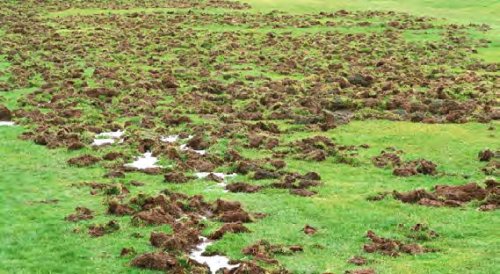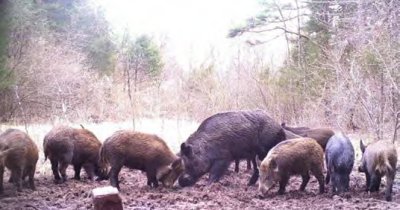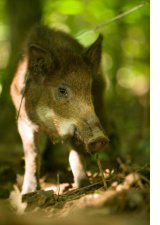AgEBB-MU CAFNR Extension
Green Horizons
Volume 24, Number 3
Fall 2020
The Fight Against Feral Hogs
Lucas Bond, Missouri Department of Conservation
A group of ten hogs can destroy 10 to 20 acres overnight, including crops, causing financial burdens
on Missouri's landowners and agricultural producers.
JEFFERSON CITY: Feral hogs are invasive, destructive pests that roam wild in certain areas of Missouri and other states. They're aggressive animals known to prey on turkey poults, fawns, freshly seeded fields, fully mature crops, as well as other wildlife. They're known to carry diseases that can be transmitted to humans, dogs and domestic pigs such as swine brucellosis, pseudorabies and others.
 |
Example of feral hog damage to pasture. |
A group of ten hogs can destroy 10 to 20 acres overnight, including crops, causing financial burdens on Missouri's landowners and agricultural producers. Damage caused by these pests was estimated at more than $1.5 billion, 10 years ago in the United States and is much higher today. That is exactly why Missouri has put together a task force to eradicate these pests. Missouri's current effort to eradicate feral hogs from the state is a multi-agency mission that involves the Missouri Department of Conservation (MDC), Missouri Department of Agriculture (MDC), U.S. Forest Service (USFS), USDA Animal and Plant Health Inspection Service (APHIS), and many more strong partners that make up the Missouri Feral Hog Elimination Partnership (MFHEP). This group, which is chaired by MDC and MDA, was formed in 2015 and is the next generation of a task force that was formed by Gov. Matt Blunt in 2007 with a goal to eradicate feral hogs from Missouri. The partnership's collaborative efforts have produced significant results, particularly in recent years. In 2020 alone, trappers have eliminated 7,482 feral hogs in Missouri through July. Since 2017, 33,932 have been eradicated.
 |
"We are turning the corner in our war on feral hogs," said Jason Jensen, who is MDC's incident commander for feral hog operations. "The incident command structure that we have employed has all the players in the partnership on the same team working in a very coordinated way. This helps to ensure accountability while avoiding duplication of effort and resources."
Jensen says that the fight is far from over, but MFHEP is definitely making a dent in feral hogs.
Report feral hog sightings or damage, and learn more about feral hog elimination at www.mdc.mo.gov/feralhogs. Sign up to receive updates from the Missouri Feral Hog Elimination Partnership at https://short.mdc.mo.gov/ZoP.
 |
"Given the significant damage that feral hogs can cause, it is important to consider the potential economic value of this damage in order to substantiate the importance of feral hog management. USDA Wildlife Services conservatively estimates that feral hog management in Missouri led by the MFHP (2016-2019) prevented a minimum of $24.9 million of agricultural production and environmental damage." -Didero & McKee 2020
